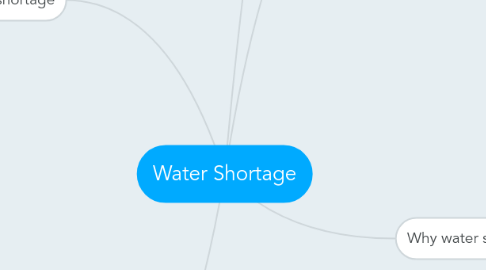
1. Impact of water shortage
1.1. Domestic impact
1.1.1. increased difficulty in collecting/accessing water
1.1.2. travel long distances to obtain water eg. some parts of Asia and Africa - 6km walk
1.1.3. limited amount allowed
1.1.4. very highly priced
1.1.5. water rationing
1.1.6. water is only made available certain times of the day
1.1.7. IMPACT: LOWER STANDARD OF LIVING INCONVENIENCE
1.2. Economic impact
1.2.1. reduced agricultural yields which may be due to unreliable rainfall
1.2.2. depletion of groundwater
1.2.3. increased cost of industrial production due to increased cost of water
1.2.3.1. particularly manufacturing
1.2.4. lack of water will lead to
1.2.4.1. shutting down of power - price of power increase - increased cost of production
1.2.4.2. higher cost of producing goods such as the beverage companies
1.3. Political impact
1.3.1. conflict - quarrels/unhappiness
1.3.2. local scale - between farmers and factory owners
1.3.3. global scale - between countries over ownership of water resources
2. How can we manage water shortage?
2.1. reduce water consumption (demand)
2.2. increase water supply
2.3. conserve through protecting water resource
3. What is water shortage?
3.1. When fresh water availability falls below 1,000 cubic metres, the country faces water scarcity.
3.2. If fresh water availability is between 1,701 adn 2,500 cubic metres, the country is said to experience water vulnerability.
3.3. If fresh water availability is between 1,001 and 1,700 cubic metres, the country is under water stress.
3.4. A country is said to have water security when there is adequate and sustainable fresh water for human consumption and use. This happens when fresh water availability is more than 2,500 cubic metres.
3.5. Water shortage occurs when the level of water usage exceeds the water supply availble. In other words, water is being used at a rate faster than it can be replenished.
3.6. A situation where the supply of water is insufficient to meet the demand of water
4. Distribution of water
4.1. locations facing water shortage
4.2. Water footprint refers to the total volume of water (in cubic metres) used to produce goods and services for a person in a year.
5. Why water shortage?
5.1. demand
5.1.1. population growth
5.1.1.1. more uses
5.1.1.1.1. economic
5.1.1.1.2. domestic
5.1.2. affluence(increasing demand)
5.1.2.1. more money
5.1.2.1.1. revolves around lifestyle
5.1.2.2. leads to higher demand for
5.1.2.2.1. more meat consumption
5.1.2.2.2. more goods and services used
5.1.2.2.3. more piped water usage for domestic uses
5.1.2.2.4. more water intensive appliances such as washing machine, dish water etc
5.2. supply
5.2.1. uneven distribution/availability of water
5.2.1.1. limited supply of water
5.2.2. climate
5.2.2.1. climate change?
5.2.2.1.1. rainfall
5.2.3. water pollution
5.2.3.1. landslides/soil erosion
5.2.3.2. industrail
5.2.3.3. public landfills (eg rivers flooded with litter)
5.2.3.4. natural water pollution (eg mud in water and such)
5.2.3.5. pesticides
5.2.3.6. livestock waste
5.2.3.7. factory waste
5.2.3.8. household sewage
5.2.3.9. impact
5.2.3.9.1. animals in the water get affected
